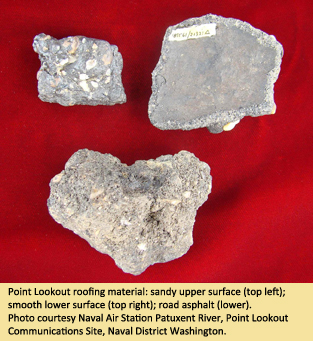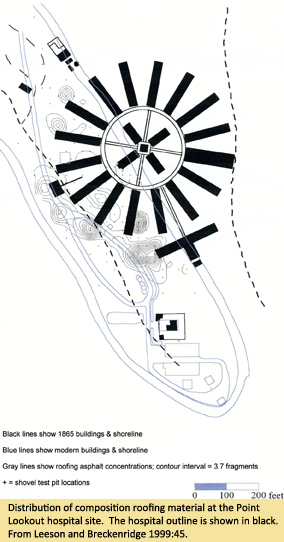Maryland Archaeological Conservation Laboratory
Main_Content
Curator's Choice 2012
Much Ado About Asphalt
January 2012
By Edward Chaney, MAC Lab Deputy Director
 During the Civil War, a state-of-the-art Federal military hospital was built at Point Lookout in St. Mary’s County. In 1995, the Naval Air Station Patuxent River hired Jefferson Patterson Park and Museum to conduct an archaeological investigation on the US Navy installation located there, so we kept our eyes peeled for artifacts associated with the hospital. A modern paved road runs through the site, and asphalt from the road was uncovered in large quantities. But strangely, the quantities did not diminish as you went farther from the road. Upon closer examination, it was clear that we actually had two types of black, asphalt-like material. One was thick and chunky, with gravel throughout. It was mostly found close to the road, and was identical to pieces of asphalt we removed from the road bed for comparison. The other was thinner, and lacked the gravel inclusions. It was smooth on one side, while the other side had a coating of sand and pebbles. What was this unusual material?
During the Civil War, a state-of-the-art Federal military hospital was built at Point Lookout in St. Mary’s County. In 1995, the Naval Air Station Patuxent River hired Jefferson Patterson Park and Museum to conduct an archaeological investigation on the US Navy installation located there, so we kept our eyes peeled for artifacts associated with the hospital. A modern paved road runs through the site, and asphalt from the road was uncovered in large quantities. But strangely, the quantities did not diminish as you went farther from the road. Upon closer examination, it was clear that we actually had two types of black, asphalt-like material. One was thick and chunky, with gravel throughout. It was mostly found close to the road, and was identical to pieces of asphalt we removed from the road bed for comparison. The other was thinner, and lacked the gravel inclusions. It was smooth on one side, while the other side had a coating of sand and pebbles. What was this unusual material?


We learned that the hospital had been built with "composition roofing," a technique that was popular in the mid-19th century as a way to waterproof flat-roofed buildings. Composition roofing consisted of cloth felt that was saturated with coal tar or something similar, and then nailed to roofing boards. The roof was then covered with more layers of tar, and finished off with a coat of sand or gravel. The “asphalt” we were finding at Point Lookout was actually composition roofing – you could even see the felt impressions on the underside of the fragments!
When we plotted out the locations on the site where we found the composition roofing, we noticed that there were numerous small clusters. Using historical maps, we compared these clusters to the assumed location of the hospital. It was clear that the roofing material was concentrated at the end of each of the hospital wards, which were arrayed like spokes on a wheel (half of the hospital site has been lost to erosion along the Chesapeake shoreline). At the war’s end, the hospital was torn down and sold for scrap. The building constituents were carted off, except for the composition roofing, which could not be recycled. Evidently, this material was scraped off the ends of the buildings before they were disassembled. Because the hospital site had been so thoroughly scavenged after the war, only the composition roofing allowed us to confirm the accuracy of the historical maps in regards to the facility’s exact location. Careful analysis of this seemingly mundane material had given us important information about the past. As JPPM’s former director, Michael Smolek, once jokingly said, it was “much ado about asphalt.”
| References |
|
| eeson, Christy E. and S. Curtis Breckenridge |
| 1999 |
Phase I Archaeological Survey of Point Lookout Tracking Station and Adjunct Theodolite Stations, Naval Air Station Patuxent River, St. Mary's County, Maryland. Report prepared for Natural Resources Branch, Department of Public Works, Naval Air Station Patuxent River. JPPM OccasionalPapers Number 7. |
|